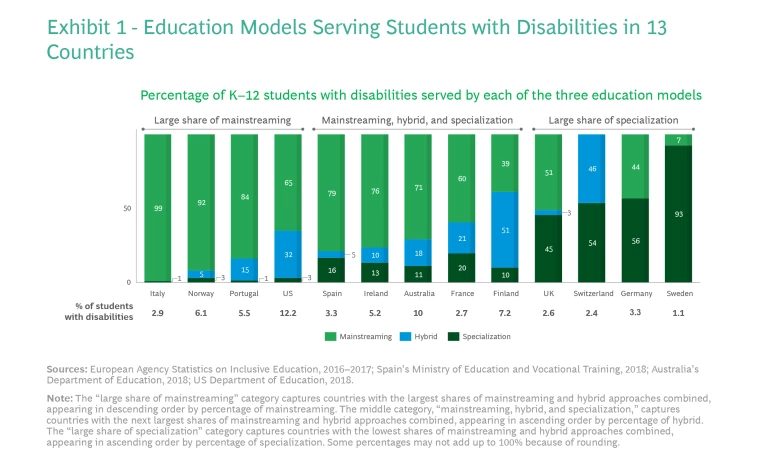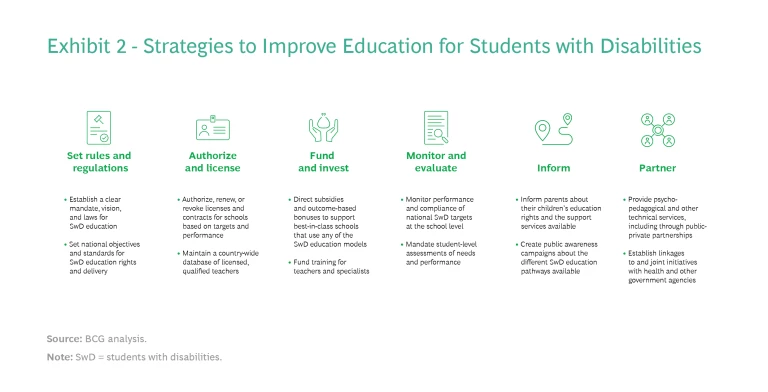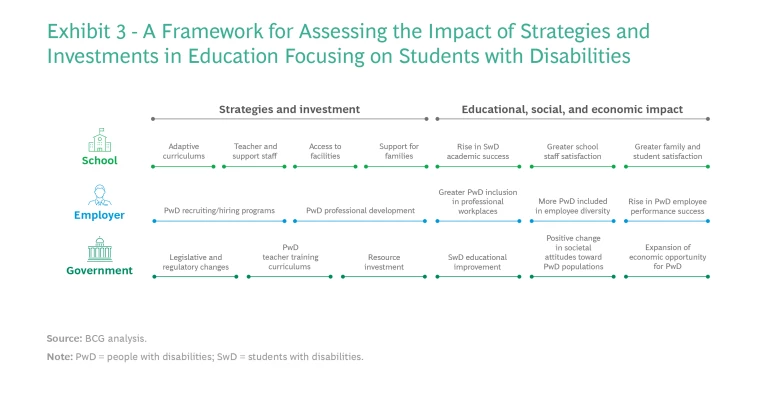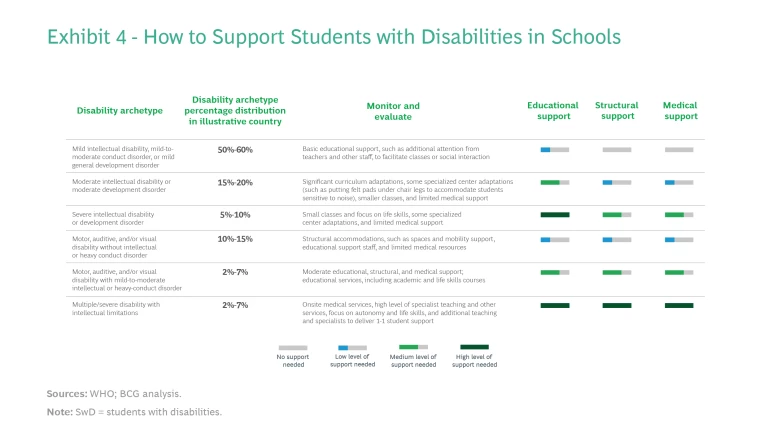An analysis of 13 developed countries’ experiences with three education models for students with disabilities offers practical guidance for policymakers and educators.
Over the last 50 years, advances in medical science and the work of the education inclusion movement have expanded human understanding of the needs and potential of persons with disabilities (PwD). As a result, a number of governments around the world have implemented life-changing
What have these reforms meant for students with disabilities? To find out, BCG conducted a study examining multiple K–12 education models and systems for students with disabilities (SwD) in 13 high-income countries: ten in Europe—Finland, France, Germany, Ireland, Italy, Norway, Portugal, Spain, Sweden, and the United Kingdom—plus Australia, Canada, and the United States. These countries were selected because they have strong laws that define and protect the educational rights of students with disabilities. With this legal foundation in place, government leaders in these countries are now focused on the policies and investments needed to support robust public and private education systems that address the needs of SwD.
Our study identified three prevalent models:
- Mainstreaming. SwD and nondisabled peers attend the same schools, are taught core subjects in the same classrooms and participate in other school activities together.
- Hybrid. This model combines mainstreaming and specialized education. Students with and without disabilities attend the same school and sometimes are in the same classrooms. Some educational content is the same for all students, while other content is specifically designed for SwD.
- Specialization. This model is dedicated to serving SwD with more complicated needs. It is used in schools designed to offer more intensive personalized attention and specialized services for these SwD.
Multiple models provide governments with the flexibility to address the diverse educational and physical needs of SwD and contend with the cultural, economic, and political considerations that shape education policy. In this article, we present research showing how countries are deploying these three models and their approaches to developing and implementing policy. Finally, we share a framework BCG created to help decision makers assess the key variables affecting the delivery of SwD education models.
A Continuum of Education Models for Students with Disabilities
In this article, we define “inclusion” as the process of enabling students with disabilities to reach their full potential in an inclusive society that welcomes them and serves their needs. Although the term “inclusion” is sometimes used synonymously with “mainstreaming, this is not our view. Mainstreaming is about the delivery process. Inclusion is about outcomes in school and in life. SwD have a wide range of cognitive/intellectual, sensory, emotional, and mobility-related disabilities and support needs. We believe that multiple models, and different combinations of models, are necessary to achieve inclusion goals for all SwD students.
As Exhibit 1 illustrates, all 13 countries examined combine the three SwD education models—mainstreaming, hybrid, and specialization—to various degrees in their education systems.
Italy, Norway, Portugal, and the US, the countries in the first category—“large share of mainstreaming”—have the biggest share of mainstreaming and hybrid combined. Specialization accounts for very small percentages. The US, for example, currently at 65% mainstreaming, has been gradually increasing mainstreaming, with 32% of SwD presently taught in hybrid settings and just 3% in specialized ones.
In the middle “mainstreaming, hybrid, and specialization” category are Spain, Ireland, Australia, France, and Finland, with the next largest share of mainstreaming and hybrid combined. These countries have a higher percentage of students served by specialized schools than the “large share of mainstreaming” category countries. In Spain, for example, the division is 79% mainstreaming, 5% hybrid, and 16% specialization.
Finally, the “large share of specialization” category countries—UK, Switzerland, Germany, and Sweden—have made specialized education a priority. As within the first two categories, there are significant differences among countries: in the UK, for example, mainstreaming is a slight majority (51%) with 45% of students with disabilities served by the specialized schools, whereas in Sweden, 93% of SwD are served by specialized schools.
The different combinations in Exhibit 1 underline the complexity of education systems today serving students with disabilities.
Key Roles and Strategies for Governments in Education
Today’s advancements in SwD education are in large part a response to nongovernmental organization’s advocacy for institutional change. This change did not happen overnight. It took decades for international conventions and national governments to establish the legal framework for developing an infrastructure and specific SwD education models. In every country examined in this study, SwD education infrastructures continue to be works in progress, continuously refined by advocates for PwD and government decision makers.
There are many levers that can be used to develop, prioritize, fund, and execute national, state, and local education policies and programs. (See Exhibit 2.)
There are many different factors driving how countries apply policy levers to shape SwD education. In countries such as Finland, Italy, and the US, the central government is the main driver of SwD education policy and laws. The Italian government committed to making mainstreaming the dominant model as far back as the 1970s; successive government leaders since then have stayed the course. By 1977, almost all specialized schools in Italy were closed. Today, as shown in Exhibit 1, only 1% of SwD in Italy are educated in specialized schools.
The US government has also used strong federal legislation to advance SwD education. In 1970, only one in five children with disabilities were educated in the nation’s public schools. The Education for All Handicapped Children Act of 1975 was the first federal law affirming all people with disabilities’ right to education. Its name was changed to the Individuals with Disabilities Education Act (IDEA) in 1990. The IDEA is the primary vehicle for rolling out federal policy, including authorizing state and local funding for early intervention and individualized education plans and key adaptive services, such as physical, occupational, and speech therapy; and supplementary aids and services, such as adaptive equipment or special communication systems. While the US utilizes all three models, the IDEA, which has been revised several times since 2004, has leaned toward expanding mainstreaming. During the 2019–2020 school year, 65% of children who received any kind of adaptive services were attending general education classes for 80% or more of their school day.
Since 2011, the Finnish government has enacted national education policy changes to reduce the number of specialized schools and increase investment in resources for teaching and early childhood diagnostics. (Prior to 2011, separate curricula for SwD students were also eliminated.) Efforts to improve data collection at the individual school and municipality levels led to a new system to monitor the impact of early detection, diagnosis, and support in mainstream schools and specialized education centers.
Our analysis of the education models in Finland from 2011 to 2019 showed the percentage of students receiving some type of adaptive SwD services rose from 12% to almost 20%, following the changes in the national education act. Today, Finland has moved away from the specialization model and is leaning toward hybrid (51%), with mainstreaming at 39% and specialization at just 10%. Finland’s experience is indicative of the time and strategic reallocation of resources required to achieve a change in model and underlying policy objectives.
In Germany, the mix of SwD models is fairly uniform around the country, but the states lead in the funding and delivery of services. All children with disabilities have the right to begin their education in a regular school; parents have the right to choose a mainstream or a specialized school. Parental decisions are informed by early-age evaluations of academic, social-emotional, and physical needs used to identify students who may be better served by in a specialized school. Each of the 16 German states have specialized primary and secondary schools providing services for students with different types of cognitive, sensory, and emotional disabilities.
Many CRPD signatories are interpretating and applying the Convention’s principles to their national policies. The UK, for example, ratified the CRPD in July 2009 and published its initial formal report on the rights of disabled people in November 2011. The CRPD’s influence is apparent in the UK government’s efforts to offer parents multiple educational options for their children. This includes a commitment to increase SwD access to mainstream schools and staff with the capacity to meet their needs.
A Framework for Assessing Education Investments and Strategies
Exhibit 3 details possible actions and investments by schools, employers, and governments to improve education for students with disabilities. It also presents potential impacts of those actions and investments on students, teachers, families, the economy, and society. The framework is designed to be a flexible tool to help decision makers assess multiple variables and navigate through many layers of complexity.
The framework is purposefully designed to be high-level and flexible enough to enable decision makers to explore multiple scenarios and analyze possible outcomes for both the school system as a whole and for specific stakeholders. It presents a selection of key baseline issues to help SwD education leaders at all levels to evaluate model options and tactical challenges and opportunities.
The framework is also designed to ensure investment analysis is not overly focused on costs and resource requirements. A comprehensive analysis and a fully informed decision must consider the implications for students’ academic achievement, teaching effectiveness, as well as the satisfaction of students, staff, and families.
The inclusion of employers in the framework aims to prompt government and business leaders to think about the relationship between K–12 education and employment opportunities. For people with disabilities, the transition to post-secondary education and inclusive employment is laden with challenges.
Exhibit 4 illustrates another approach we developed that can be used to guide choices and decisions regarding costs, needs, tradeoffs, choosing strategies across multiple models. We identify six disability archetypes, break out the SwD population by size and archetype, and describe the specific needs for each of these archetypes. Finally, we estimate the level services and accommodation for each archetype across three categories: educational, structural (such as space and mobility), and medical support needed. (See Exhibit 4.)
Acting to Improve K-12 Education for Students with Disabilities
Although it is difficult to make judgments about the efficacy and challenges of specific education models without context, some high-level observations can be made:
- Mainstreaming can benefit children with milder disabilities—both academically and socially. Governments have a duty to offer a model that gives SwD who can thrive in classrooms and sharing activities with students without disabilities this opportunity. However, some students with mild intellectual disabilities may be left behind, especially as teenagers. This can have a variety of immediate and long-term effects on their development and mental health.
- Hybrid SwD education approaches may offer the widest range of academic and economic options. Streamlining of investments, better management of class size and the composition of students in classrooms are examples of efficiencies that could be introduced with hybrid models. However, this model increases the complexity in assigning SwD to schools that have the right adaptive resources.
- Specialization has a key role in serving students for whom neither mainstreaming nor hybrid is the best option. Specialization is generally applied to a lower percentage of students. Often, they are students with the most significant accommodation needs. Specialization schools can be resource intensive and expensive. However, it is important to note that it may be more costly (and sometimes ineffective) to serve this cohort of SwD in nonspecialized schools. Costs of specialization can also be reduced through standardization of services.
Below we highlight seven actions where government leadership could strengthen each of the SwD education models, and inspire new innovations:
- Use laws, regulation, and language, within and across countries, to promote a common vision of goals and definitions of success. UN’s Sustainable Development Goal 4—“ensure inclusive and equitable quality education and promote lifelong learning opportunities for all”—is an important directive for countries. As noted earlier, signatories of the CRPD use the Convention to guide education policy and other PwD quality of life areas such as health, employment, physical access, discrimination, and athletics. The influence of the CRPD is notable in both the UK and Australia’s current ten-year plans for PwD education.
- Ensure SwD education has a clearly defined and differentiated regulatory framework. Review the content and alignment of current laws and policies regulating specialized education. Select key areas, such as identifying the methodologies for collecting SwD data and areas for improvement. Prepare guidelines and rules to be included in nationwide regulation.
- Promote sharing of education and employment best practices within countries. Review best practices and learn from experienced and high-performing schools and companies. Create guidelines and shared repositories for information and resources. Use training modules, workshops, and other programs so people responsible for PwD in schools and companies can share and implement best practices.
- Improve national and school level data collection and performance measurement of processes and outcomes.
A 2018 World Bank brief on inclusive education called for “better data,” specifically, data on student participation and academic
outcomes.3 3 “Inclusive Education,” World Bank, November 9, 2018. It would also be relevant to develop data collection and measurement systems to assess employment outcomes and personal integration into society. Today, data on SwD remains scarce, and most data available measure processes rather than outcomes. Our study found a limited number of national and subnational government initiatives collecting student and teaching performance data. The Australian government’s Nationally Consistent Collection of Data on School Students with Disability initiative, for example, has collected data nationally to create standard ways to categorize different adaptive requirements and student needs. - Increase standardization and quantification of psycho-pedagogical assessments. Standardization involves multiple steps: review the current variables, select and quantify a set of common variables, define new evaluation standards, review psycho-pedagogical technician roles in assessments, and standardize processes for selecting these technicians and reviewing their performance.
- Update teacher training curricula. This includes defining teacher requirements in all types of schools and for different education models—and ensuring teachers receive adaptive training in core subjects. Schools can leverage existing knowledge and best practices to improve teacher training. Reviewing teacher licensing and renewal requirements in state-funded schools (and private schools, if applicable) is crucial. These actions could also affect teaching degree requirements.
- Enhance academic training for all disability-focused professionals. Update degree requirements, assessments for enrollment, and monitor completion of degrees. This should include undergraduate and graduate programs and continuing education for professionals.
The COVID-19 pandemic has been a challenging time for students, parents, and teachers around the world. In particular, remote learning has presented obstacles for SwD with more complicated needs—those who rely on more personalized attention and specialized services. As countries undertake the road to recovery, there is a significant opportunity for education leaders to address the effects of the pandemic and improve education systems to better serve all students.
The authors thank BCG colleague Soeren Palumbo for his support and review of this article.









